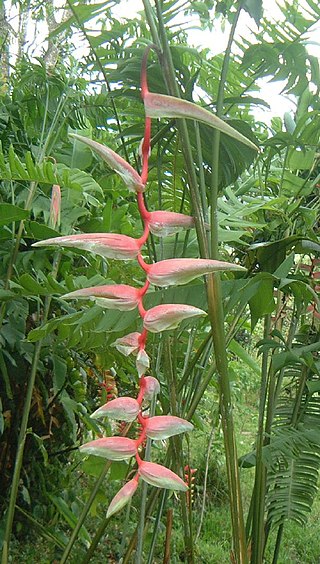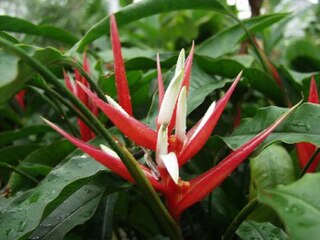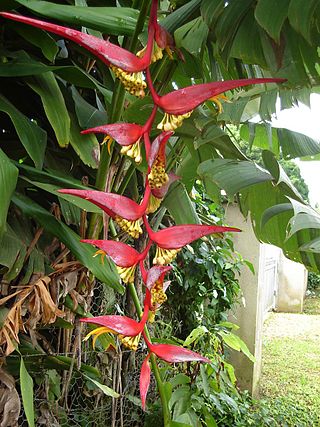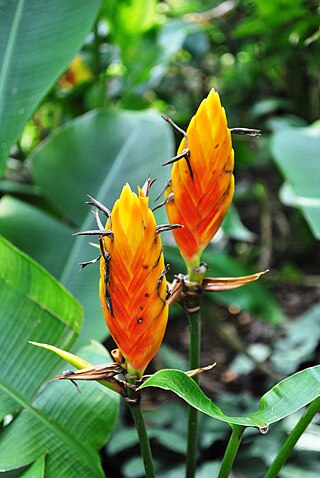
The Zingiberales are flowering plants forming one of four orders in the commelinids clade of monocots, together with its sister order, Commelinales. The order includes 68 genera and 2,600 species. Zingiberales are a unique though morphologically diverse order that has been widely recognised as such over a long period of time. They are usually large herbaceous plants with rhizomatous root systems and lacking an aerial stem except when flowering. Flowers are usually large and showy, and the stamens are often modified (staminodes) to also form colourful petal-like structures that attract pollinators.

Heliconia is a genus of flowering plants in the monotypic family Heliconiaceae. Most of the ca 194 known species are native to the tropical Americas, but a few are indigenous to certain islands of the western Pacific and Maluku in Indonesia. Many species of Heliconia are found in the tropical forests of these regions. Most species are listed as either vulnerable or data deficient by the IUCN Red List of threatened species. Several species are widely cultivated as ornamentals, and a few are naturalized in Florida, Gambia, and Thailand.

The rufous-breasted hermit or hairy hermit is a hummingbird that breeds from Panama south to Bolivia, and on Trinidad, Tobago and Grenada. It is a widespread and generally common species, though local populations may change in numbers and disappear altogether in marginal habitat.

Heliconia chartacea is a species of Heliconia native to tropical South America.

Nepenthes hirsuta, the hairy pitcher-plant, is a tropical pitcher plant endemic to Borneo. It is characterised by an indumentum of thick brown hairs, which is even present on the inflorescence. Pitchers are mostly green throughout with some having red blotches on the inside surfaces.

Heliconia acuminata is a species of plant in the family Heliconiaceae. It is an erect herb, typically growing 1.6 m tall, native to the South American countries of Brazil, French Guiana, Guyana, Suriname, Venezuela, Colombia, Bolivia and Peru. It is also grown as an ornamental plant in other regions.

Heliconia angusta Vell., of family Heliconiaceae is an erect herb typically growing 0.70 m tall, native to Brazil.

Heliconia bihai of the family Heliconiaceae is an erect herb typically growing taller than 1.5 m. It is native to northern South America and the West Indies. It is especially common in northern Brazil and the Guianas but also found in Hispaniola, Jamaica, the Lesser Antilles, Puerto Rico, Trinidad, Venezuela and Colombia. Other names by which the plant is commonly known include balisier and macawflower.

Heliconia collinsiana (platanillo) of family Heliconiaceae is an erect herb typically growing 10–15 feet (3.0–4.6 m) tall, native to Guatemala, Honduras, El Salvador, Nicaragua and southern Mexico.

Heliconia episcopalis is a species of plant in the family Heliconiaceae. It is an erect herb typically grows up to 2 meters tall, native to the Amazon Rainforest, in Colombia, Venezuela, Guyana, French Guiana, Suriname, Brazil, Ecuador, and Peru in South America.

Heliconia tortuosa is an herbaceous tropical perennial commonly found in secondary succession in montane forests in Central America and southern Mexico. It is moderately shade tolerant. It has also been widely cultivated as a garden plant for its showy, usually twisted inflorescences.

Heliconia rostrata, the hanging lobster claw or false bird of paradise, is a herbaceous perennial plant native to El Salvador, Peru, Bolivia, Colombia, Venezuela, Costa Rica, and Ecuador, and naturalized in Puerto Rico. Other heliconias grow in an upright position, their cup-shaped flower bracts storing water for birds and insects. This plant, however, has downward-facing flowers, the flowers thus providing a source of nectar to birds.

Arabis hirsuta, known as hairy rock-cress, is a flowering plant of the genus Arabis in the family Brassicaceae. In previous North American works, this species has been broadly defined to include plants native to Europe, Asia, and the northern half of North America, but is now more often restricted to a narrower subgroup restricted to Europe.

The white-tipped sicklebill is a species of hummingbird in the family Trochilidae. It is found in Colombia, Costa Rica, Ecuador, Panama, Peru, and Venezuela.

The hook-billed hermit is a threatened species of hummingbird in the family Trochilidae. It is endemic to a small area of Brazil.
The name is derived from the Greek word Ἑλικώνιος (helikṓnios) meaning Lobster Claws, another word for Heliconias. The second part is from the Latin word Excelsa, sometimes meaning tall, probably meaning "tall Lobster Claw" all together. Heliconia excelsa is a species of plant in the family Heliconiaceae. It is endemic to Ecuador. Its natural habitat is subtropical or tropical moist lowland forest. At its maturity, it can reach a height of 8' to 12' or 15' in full sun to half shade.

Heliconia psittacorum is a perennial herb native to the Caribbean and South America. It is considered native to French Guiana, Guyana, Suriname, Venezuela, Colombia, Bolivia, Brazil, Paraguay, Panama and Trinidad and Tobago. It is reportedly naturalized in Gambia, Thailand, Puerto Rico, Hispaniola, Jamaica and the Lesser Antilles. It is often cultivated as a tropical ornamental plant in regions outside its native range.

Heliconia latispatha is a plant species native to southern Mexico, Central America and northern South America and naturalized in Florida and Jamaica. It is an herbaceous perennial up to 4 m tall, with leaves resembling those of bananas. The inflorescence is erect, up to 45 cm long, with red or orange bracts subtending green, yellow or orange flowers.

Indigofera hirsuta, the hairy indigo or rough hairy indigo, is a species of flowering plant in the family Fabaceae. It is native to nearly all the world's tropics; South America, Africa, Madagascar, the Indian Subcontinent, southern China, southeast Asia, Malesia, Papuasia and Australia, and has been introduced to the Caribbean, the southeast United States, Mexico and Central America. It is used as a green manure and, to a minor extent, for forage.

Kohleria hirsuta, the woolly kohleria, is a species of flowering plant in the family Gesneriaceae, native to northern South America, and introduced to the Dominican Republic. In 1993, as its synonym Kohleria eriantha, it gained the Royal Horticultural Society's Award of Garden Merit as a hothouse plant, but the award appears to have been recently revoked.







